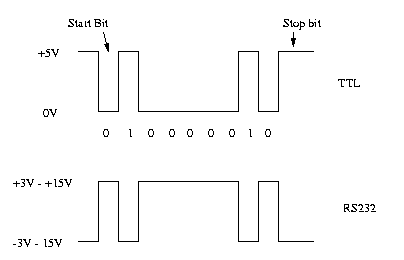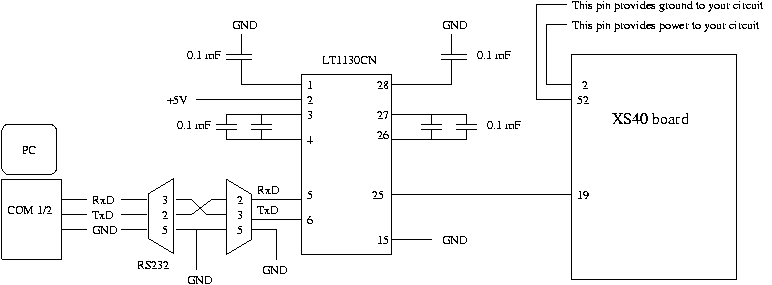
Fig 1. Serial Waveforms
A Simplified VHDL UART
Introduction
In embedded systems, the processor that we choose for our design may not come with built-in peripherals. Therefore, designers will have to implement these devices in hardware keeping in mind that they will need to interface to the processor. In this lab we will design a simplified UART (Universal Asynchronous Reciever Transmitter) in VHDL and download it to the FPGA on the XS40 baord.
Serial communication is often used either to control or to receive data from an embedded microprocessor. Serial communication is a form of I/O in which the bits of a byte begin transferred appear one after the other in a timed sequence on a single wire. Serial communication has become the standard for intercomputer communication. In this lab, we'll try to build a serial link between 8051 and PC using RS232.
RS232C:
The example serial waveforms in Fig 1 show the waveform on a
single conductor to transmit a byte (0x41) serially. The upper waveform
is the TTL-level waveform seen at the transmit pin of 8051. The lower
waveform shows the same waveform converted to RS232C levels. The voltage
level of the RS232C are used to assure error-free transmission over greater
distances than would be possible with TTL levels.
As shown in Fig 1, each byte is preceded by a start bit and followed
by one stop bit. The start and stop bits are used to synchronize the
serial recievers. The data byte is always transmitted
least-significant-bit first. For error checking it is possible to
include a parity bit as well, just prior to the stop bit. The bits are
transmitted at specific time intervals determined by the baud rate
of the serial signal. The baud rate is the reciprocal of the time to send
1 bit. Error-free serial communication requires that the baud rate, number
of data bits, number of stop bits, and presence or absence of a parity bit
be the same at the transmitter and at the receiver.

Fig 1. Serial Waveforms
RS232 connector:
PCs have 9pin/25pin male SUB-D connectors. The pin layout is as follows
(seen from outside your PC):
1 13 1 5
_______________________________ _______________
\ . . . . . . . . . . . . . / \ . . . . . /
\ . . . . . . . . . . . . / \ . . . . /
--------------------------- -----------
14 25 6 9
Name (V24) 25pin 9pin Dir Full name Remarks
--------------------------------------------------------------------------
TxD 2 3 o Transmit Data
RxD 3 2 i Receive Data
RTS 4 7 o Request To Send
CTS 5 8 i Clear To Send
DTR 20 4 o Data Terminal Ready
DSR 6 6 i Data Set Ready
RI 22 9 i Ring Indicator
DCD 8 1 i Data Carrier Detect
GND 7 5 - Signal ground
- 1 - - Protective ground Don't use this one
for signal ground!
The most important lines are RxD, TxD, and GND. Others are used with
modems, printers and plotters to indicate internal states.
In this lab, we are going to use
serial.exe, to communicate between the PC and the 8051.
UART Clock Divider:
The UART that we are designing will be transmitting data at a rate of 1200 baud, or 1200 bps. However, since the FPGA and 8051 on the XS40 board operates at 12 MHz, simply transmitting one bit every clock cycles will be too fast. Therefore, we will need to create a clock divider that will be used by the UART to transmit one bit per cycle. The input to the clock divider will be a 12 MHz clock and the output should be a 1200 Hz clock.
Apparatus Required:
Schematic:

Procedure:
NOTE: Becuase the CPU read/write process and
UART transmit process have different clock signals as
input, it will be neccessary to use handshaking signals
between the two.
NOTE:If you are unsure of how to compile
and download, refer to the
Music Generator Lab